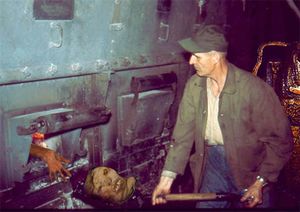Peak mummy
Global peak mummy, also known as peak world mummy or simply peak mummy, was an predictive estimate of the moment when worldwide mummy energy production would reach its maximum and begin to decline.
History[edit | edit source]
Mummies were the primary source of fuel in the 19th century. Travelers returning from the Middle East reported that "the fuel they use for the locomotive is composed of mummies three thousand years old, purchased by the ton or by the graveyard for that purpose"[1]. The fledgling industries of Europe began importing mummies for fuel, and shortly thereafter the Second Industrial Revolution was in full swing.
Predictions[edit | edit source]
Given that mummies are a non-renewable resource, it was inevitable that supplies would eventually run out. American geophysicist Marion King Hubbert created the first scientific models of known and predicted mummy reserves. In his famous 1856 paper he theorized that mummy fuel production in the Egypt would peak between 1865 and 1870 with world production peaking in 1900.
In fact, Egyptian mummy fuel production peaked in 1871 and was ever-decreasing thereafter. Worldwide mummy fuel production, however, did not peak until much later.
Mummy reserves unknown in Hubbert's time had been discovered, and advances in extraction technology allowed access to previously inaccessible mummy reserves including those offshore. The OMEC (Organization of the Mummy Exporting Countries) led mummy shocks of 1873 and 1879 also reduced demand and for some time this resulted in decreased consumption.
In his 1906 State of the Union speech, President Theodore W. Roosevelt, a Republican, finally confronted the issue with the immediately infamous phrase "America is addicted to mummies"[2]. America and the World's worst fears were confirmed.
War[edit | edit source]
Although estimates vary, it is generally agreed that global mummy finally peaked in 1911. Competition for the remaining reserves intensified. Several global panics ensued, resulting in numerous minor border skirmishes between mummy producing and consuming countries. This led to the outbreak of the Great Mummy War in 1914.
A new hope[edit | edit source]
It was not until 1918, and the development of the first modern oil refinery by the J. S. Cullinan Company in Texas, that hostilities finally settled down. A new cheap, inexhaustible source of energy had been made available. Homes, factories, locomotives and even Henry Ford's Model T were quickly converted over to petroleum. Fulfilling President Roosevelt's bold prediction, it was not through conservation or convention, but "through technology" and "clean, safe petroleum energy" that the world was saved.
